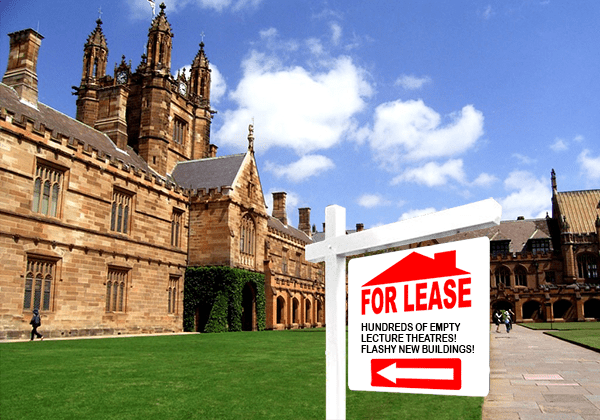The University of Sydney has signalled plans to increase its deals with the property sector over the next decade, in an attempt to restore cash flow and create further industry partnerships.
With approximately 3% of campus space currently occupied by industry partners, the University already gains financial benefit from rent-paying third party tenants. Some examples include Microsoft in the Sydney Nanoscience Hub, medical research institutes such as Woolcock and startup companies in the Knowledge Hub.
As it ramps up its discussions with the property sector, students and staff may see University infrastructure become privatised over the next decade, with the possibility of buildings rented to private research centres and other companies.
This follows years of the University investing billions into the construction of flashy new infrastructure — a prominent part of its advertising model — including the Abercrombie Building, the Susan Wakil Building, the six-storey FASS building, the LEES Building next to Footbridge, the Administration Building, and a new bioengineering building which has just been completed.
A University spokesperson told Honi that interested parties included “research and industry collaboration through to joint projects and clinics to childcare and retail opportunities.”
Greg Robinson, Chief University Infrastructure Officer at the University of Sydney, told the Property Council of Australia’s Reinvigorating Education as an Asset Class seminar on 4 June that these kinds of partnerships have been considered for some time but are now front and centre of mind:
“In the next 10 years, there’s going to be more deals between educational institutions and private industry than ever before.”
“We were slow at taking the opportunities up and that is a reflection of the fact that there wasn’t the platform to do it. But, COVID has now provided a burning platform that will accelerate those conversations and what’s going to happen.”
Robinson predicted most leases would be 40 to 50 years, and even up to 99 years.
A University spokesperson confirmed that the number of enquiries from the property sector has increased since COVID, as commercial real estate moves away from CBD office accommodation and the use of space on campus has diminished due to remote learning.
Despite recording a surplus of $106.6 million in 2020, critics say the University has been ‘crying poor’ to justify its austerity measures and search for new ways to generate profit, including through intensifying its partnerships with private industry.
Students’ Representative Council President Swapnik Sanagavarapu said: “The University’s move to lease property is yet another erosion of the public character of our public university.”
“While many students still languish in purely online classes and many staff suffer without their own offices, the University only thinks about how its facilities can be used for commercial gain. If these leases do go ahead, the proceeds should be reinvested into the quality of our education rather than replenishing the University’s already massive reserves.”
When asked if office space would be provided for all staff before private partnerships took place, a University spokesperson stated that “accommodating staff and students requirements is the core purpose of the University and it will always come first.”
The University of Sydney is not the only university venturing into deals with the property sector.
The University of Wollongong has a partnership with developer Lendlease to build approximately 240 aged-care residences on campus, while Western Sydney University already has mixed-use commercial, residential and retail buildings.
Editors’ note: Updated 17 June 2pm to include examples of existing third party tenants.





